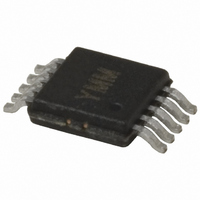MIC2164-3YMM Micrel Inc, MIC2164-3YMM Datasheet - Page 14

MIC2164-3YMM
Manufacturer Part Number
MIC2164-3YMM
Description
IC PWM BUCK CNTLLR 10MSOP
Manufacturer
Micrel Inc
Series
Hyper Speed Control™r
Type
Step-Down (Buck)r
Datasheet
1.MIC2164YMM.pdf
(39 pages)
Specifications of MIC2164-3YMM
Internal Switch(s)
No
Synchronous Rectifier
Yes
Number Of Outputs
1
Voltage - Output
0.8 ~ 5.5 V
Frequency - Switching
1MHz
Voltage - Input
3 ~ 5.5 V
Operating Temperature
-40°C ~ 125°C
Mounting Type
Surface Mount
Package / Case
10-MSOP, Micro10™, 10-uMAX, 10-uSOP
Voltage - Supply
3 V ~ 28 V
Frequency-max
1.25MHz
Duty Cycle
66%
Pwm Type
Controller
Buck
Yes
Boost
No
Flyback
No
Inverting
No
Doubler
No
Divider
No
Cuk
No
Isolated
No
Lead Free Status / RoHS Status
Lead free / RoHS Compliant
Other names
576-3544-5
Micrel, Inc.
Figure 3 shows the load transient scenario of the
MIC2164/-2/-3 converter. The output voltage drops due
to the sudden load increasing, which would cause the
FB voltage to be less than V
comparator to trigger ON-time period. At the end of the
ON-time period, a minimum OFF time T
generated to charge BST since the FB voltage is still
below the V
triggered due to the low FB voltage. Therefore, the
switching frequency changes during the load transient.
With the varying duty cycle and switching frequency, the
output recovery time is fast and the output voltage
deviation is small in MIC2164/-2/-3 converter.
Unlike the current-mode control, MIC2164/-2/-3 uses the
output voltage ripple, which is proportional to the
inductor current ripple if the ESR of the output capacitor
is large enough, to trigger an ON-time period. The
predetermined ON time makes MIC2164/-2/-3 control
loop has the advantage as the adaptive on-time mode
control. Therefore, the slope compensation, which is
necessary for the current-mode control, is not required in
the MIC2164/-2/-3 family.
September 2010
Figure 3. MIC2164/-2/-3 Load-Transient Response
Figure 2. MIC2164/-2/-3 Control Loop Timing
REF
. Then, the next ON-time period is
REF
. This will cause the error
OFF(min)
is
14
The MIC2164/-2/-3 family has its own stability concern:
the FB voltage ripple should be in phase with the
inductor current ripple and large enough to be sensed by
the g
recommended minimum FB voltage ripple is 20mV. If a
low ESR output capacitor is selected, then the FB
voltage ripple may be too small to be sensed by the g
amplifier and the error comparator. Also, the output
voltage ripple and the FB voltage ripple are not in phase
with the inductor current ripple if the ESR of the output
capacitor is very low. Therefore, the ripple injection is
required for a low ESR output capacitor. Please refer to
“Ripple Injection” subsection in “Application Information”
for more details about the ripple injection.
Soft-Start
Soft-start reduces the power supply input surge current
at startup by controlling the output voltage rise time. The
input surge appears while the output capacitor is
charged up. A slower output rise time will draw a lower
input surge current.
MIC2164/-2/-3 implements an internal digital soft-start by
making the 0.8V reference voltage V
100% in about 6ms with a 9.7mV step. Therefore, the
output voltage is controlled to increase slowly by a stair-
case V
circuitry is disabled to reduce the current consumption.
V
the soft-start function behavior correctly.
Current Limit
The MIC2164/-2/-3 uses the R
power MOSFET to sense over-current conditions. The
lower-side MOSFET is used because it displays much
lower parasitic oscillations during switching then the
high-side MOSFET. Using the low-side MOSFET R
as a current sense is an excellent method for circuit
protection. This method will avoid adding cost, board
space and power losses taken by discrete current sense
resistors.
In each switching cycle of the MIC2164/-2/-3 converter,
the inductor current is sensed by monitoring the low-side
MOSFET in the OFF period. The sensed voltage is
compared with a current-limit threshold voltage V
a blanking time of 150ns. If the sensed voltage is over
V
the MIC2164/-2/-3 turns off the high-side MOSFET and a
soft-start sequence is trigged. This mode of operation is
called the “hiccup mode” and its purpose is to protect the
down stream load in case of a hard short. The current
limit threshold V
to the FB voltage. Please refer to the “Typical
Characteristics” for the curve of V
circuit in Figure 4 illustrates the MIC2164/-2/-3 current
limiting circuit.
IN
CL
, which is 130mV typical at 0.8V feedback voltage,
should be powered up no earlier than V
m
REF
amplifier and the error comparator. The
ramp. Once the soft-start ends, the related
CL
has a fold back characteristics related
DS(ON)
CL
vs. FB voltage. The
REF
MIC2164/-2/-3/C
M9999-091310-D
of the low-side
ramp from 0 to
HSD
to make
CL
DS(ON)
after
m












